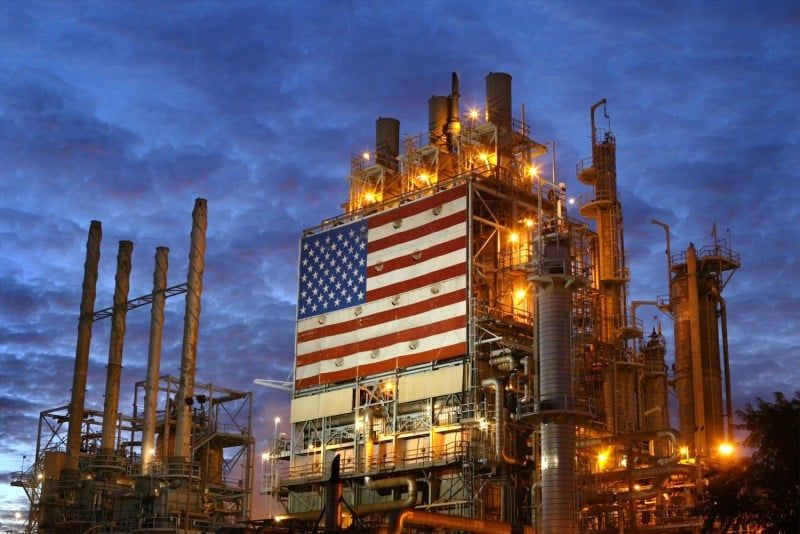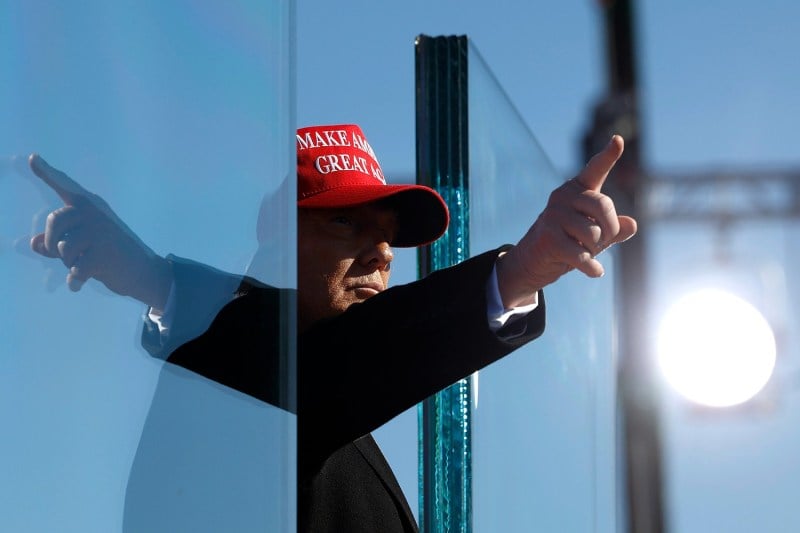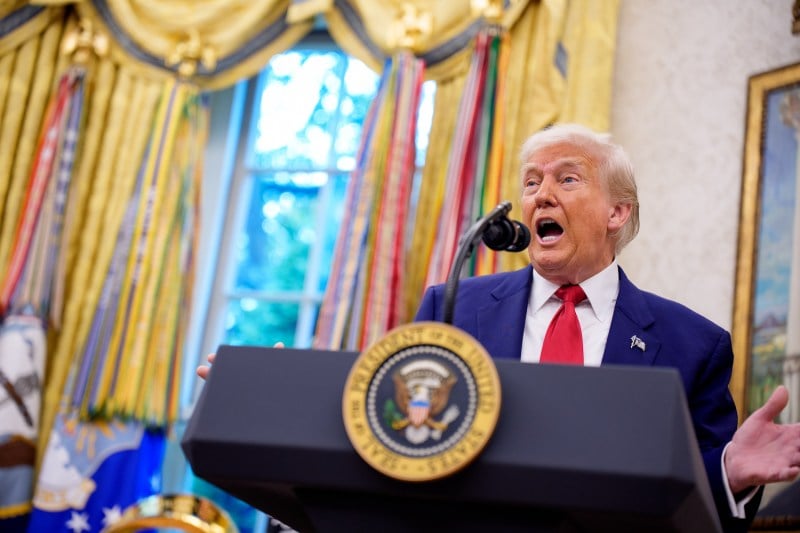Trump’s Tariffs Are Killing His Plans for Energy Dominance

Trump’s Tariffs Are Killing His Plans for Energy Dominance
The new duties have brought down oil prices, but cheap oil is bad for the United States these days.
The Wilmington ARCO refinery in Los Angeles, California, on Dec. 19, 2003. Photo by David McNew/Getty Images
U.S. President Donald Trump promised to bring down energy prices, and on that front at least, he has delivered.
Thanks to his trade war, crude oil prices have plunged. Benchmark prices in New York and London are down about 15 percent in the last few days, a drop that is matched only by the declines on Wall Street, in Asian stock markets, and in Tesla’s appeal. Crude oil went from the mid $70s a barrel when Trump was elected the second time to the upper $50s (briefly) on Monday.
U.S. President Donald Trump promised to bring down energy prices, and on that front at least, he has delivered.
Thanks to his trade war, crude oil prices have plunged. Benchmark prices in New York and London are down about 15 percent in the last few days, a drop that is matched only by the declines on Wall Street, in Asian stock markets, and in Tesla’s appeal. Crude oil went from the mid $70s a barrel when Trump was elected the second time to the upper $50s (briefly) on Monday.
The good news, such as it is, is that cheaper oil is a win, as Treasury Secretary Scott Bessent gleefully said. Cheaper oil means cheaper gasoline. The bad news is that there may not be jobs to drive to.
Global markets have not responded kindly to Trump’s war on trade, and serious economists (and even investment bankers) worry about a recession. It might get worse: On Monday, Trump threatened China with additional 50 percent tariffs on top of the 34 percent tariff imposed last week, which itself came atop the 20 percent tariffs previously levied, in addition to all other tariffs, which are also still in effect.
Cheap oil is, in a reversal from decades past, bad news for the United States—and especially for some deeply Republican parts of the country, which have in the past decade and a half revolutionized the oil business and made the United States the greatest producer of oil and natural gas in the history of the world. The United States pumped about 13.2 million barrels of oil a day on average last year; Saudi Arabia isn’t even in the double digits at the moment.
The problem dates from last week, when Trump launched a trade war against every country on earth, which has led the world to worry about rising prices and slowing growth. Recessions mean less demand for oil, which is why West Texas and Brent crude have spent the last few days in the red, and are still looking sickly.
That would have been bad enough for the oil patch. But Trump also put tariffs on steel imports. It just so happens that the United States imports many of the pipes, tubes, and casings that are used in the oil and gas industry. So higher costs for production, coupled with a lower price for the product, are suboptimal, despite the Trump administration’s vows to turbocharge the U.S. energy business.
“Deglobalization creates headwinds for energy dominance,” said Kevin Book, the founder of ClearView Energy Partners, an energy consultancy.
The reason that cheaper oil is bad is because the United States’ oil patch is not a low-cost producer, like those of countries such as Saudi Arabia and Iraq are. Blasting apart the earth’s underbelly with pipes and proppants and horizontal rigs is an expensive undertaking. It’s hard to say exactly what the break-even price is for U.S. shale producers, or, perhaps more to the point, where their break-in point is for drilling new holes. It is somewhere between $45 and $60 a barrel. The market is perilously close right now to killing the golden goose.
It’s not just oil, though. U.S. natural gas is not just a big business—it has also been a big export business. Europe, before things escalated, was talking about buying more liquefied natural gas to pacify Trump, and also as a way to wean for good off Russian energy supplies. Japan, South Korea, and even China were big takers of U.S. gas in recent years. South Korea and Japan were two other big targets of Trump’s latest trade salvo.
China, in addition to its 34 percent reprisals, announced a freeze on purchases of U.S. gas. The last time that Beijing did that, during another Trump trade war, it lasted more than a year.
“You don’t want to lose the Asia-Pacific market,” said Anne-Sophie Corbeau, an energy expert at Columbia University’s Center for Global Energy Policy. “Trump wants to sell more U.S. LNG, but he is doing things that move us in the opposite direction.”
Trump’s trade wars may be called off this week, or they may escalate. The fact that nobody knows is precisely part of the problem—and the reason that markets are nervous, investors are skittish, and drillers are hard to get on the phone. Tariffs may or may not restore U.S. industrial dominance, but one thing is for sure: They are doing no favors for the United States’ plans for energy dominance.
This post is part of FP’s ongoing coverage of the Trump administration. Follow along here.
Keith Johnson is a reporter at Foreign Policy covering geoeconomics and energy. X: @KFJ_FP
More from Foreign Policy
-

American flags are draped around tables and pipes in a small factory room as women work at sewing machines to produce them. Tariffs Can Actually Work—if Only Trump Understood How
Smart trade policy could help restore jobs, but the president’s carpet-bomb approach portends disaster.
-

Donald Trump looks up as he sits beside China’s President Xi Jinping during a tour of the Forbidden City in Beijing on Nov. 8, 2017. Asia Is Getting Dangerously Unbalanced
The Trump administration continues to create headlines, but the real story may be elsewhere.
-

Trump announces tariffs Trump’s Wanton Tariffs Will Shatter the World Economy
Economic warfare is also a test for U.S. democracy.
-

The Department of Education building in Washington, DC on March 24. Why Republicans Hate the Education Department
Broad popular support means that even Ronald Reagan failed at dismantling the agency.









Join the Conversation
Commenting on this and other recent articles is just one benefit of a Foreign Policy subscription.
Already a subscriber?
.
Subscribe
Subscribe
View Comments
Join the Conversation
Join the conversation on this and other recent Foreign Policy articles when you subscribe now.
Subscribe
Subscribe
Not your account?
View Comments
Join the Conversation
Please follow our comment guidelines, stay on topic, and be civil, courteous, and respectful of others’ beliefs.
Change your username |
Log out
Change your username:
CANCEL
Confirm your username to get started.
The default username below has been generated using the first name and last initial on your FP subscriber account. Usernames may be updated at any time and must not contain inappropriate or offensive language.